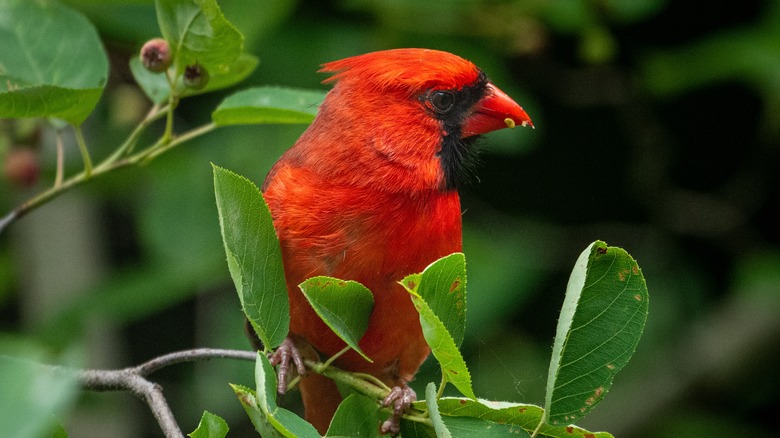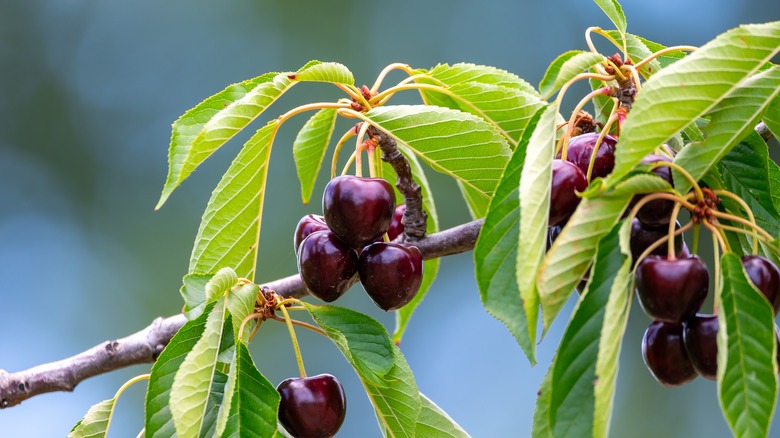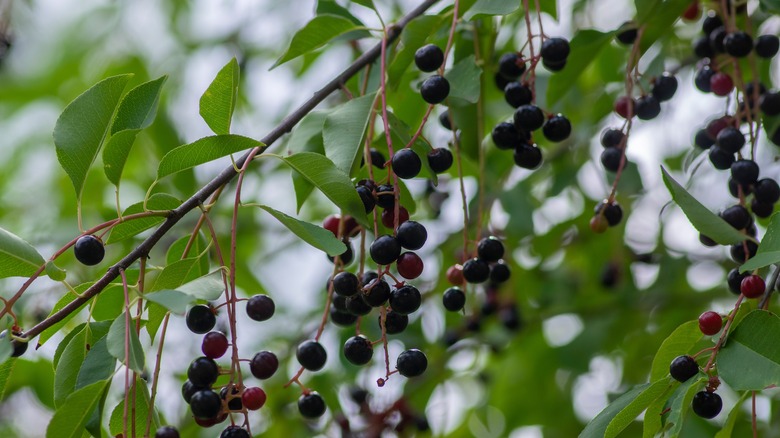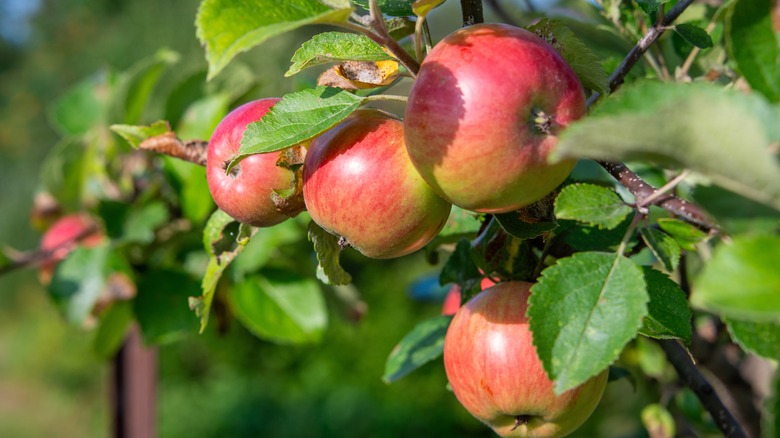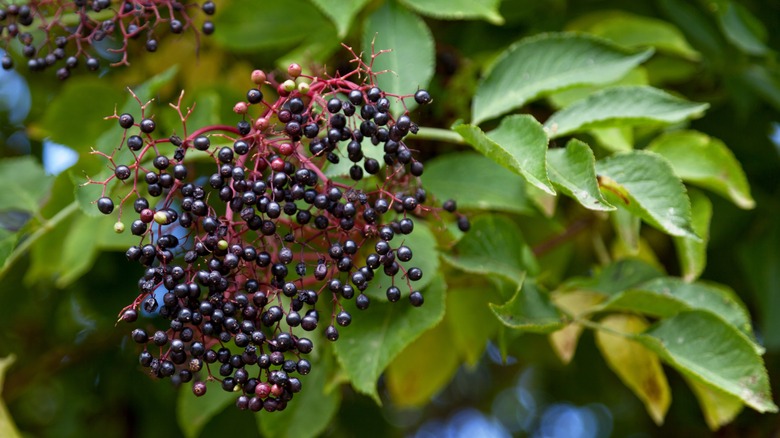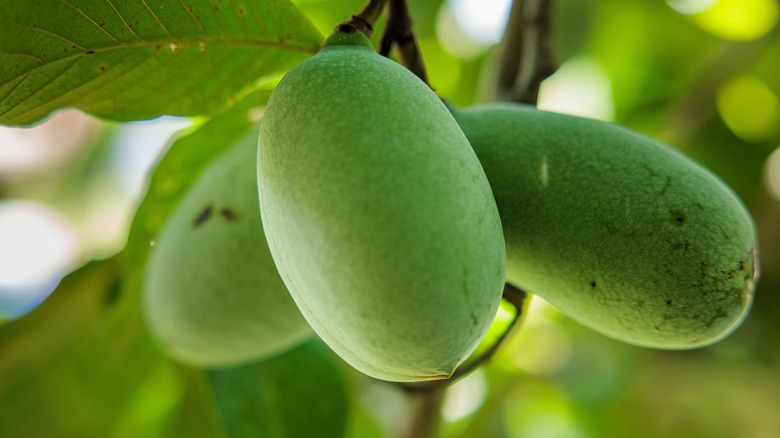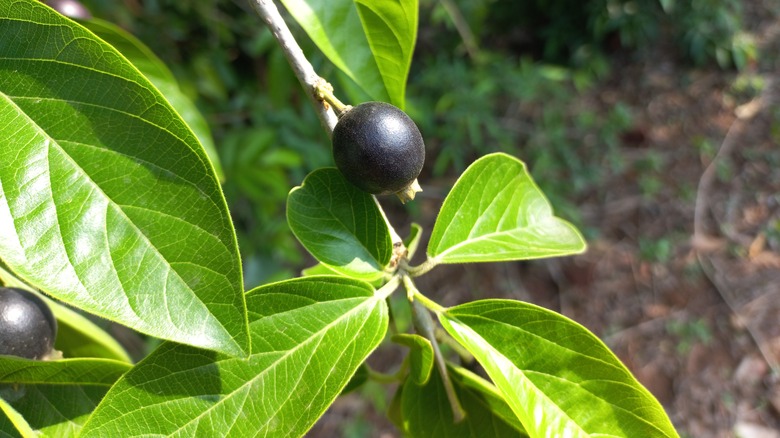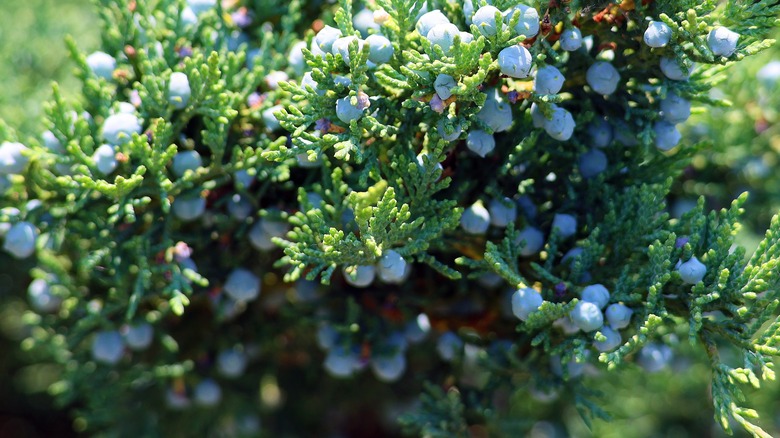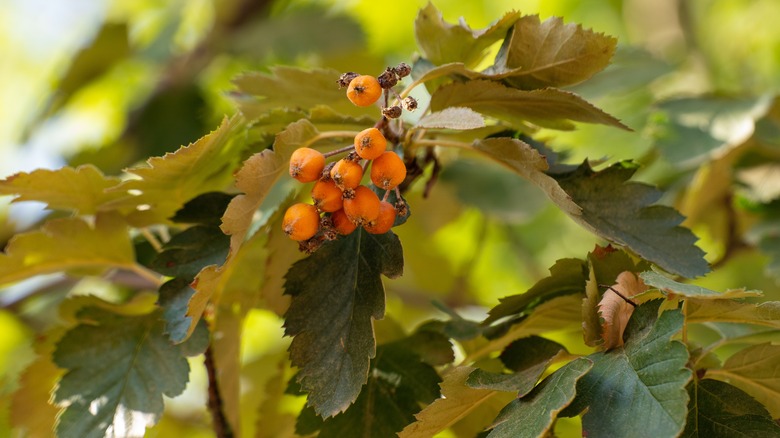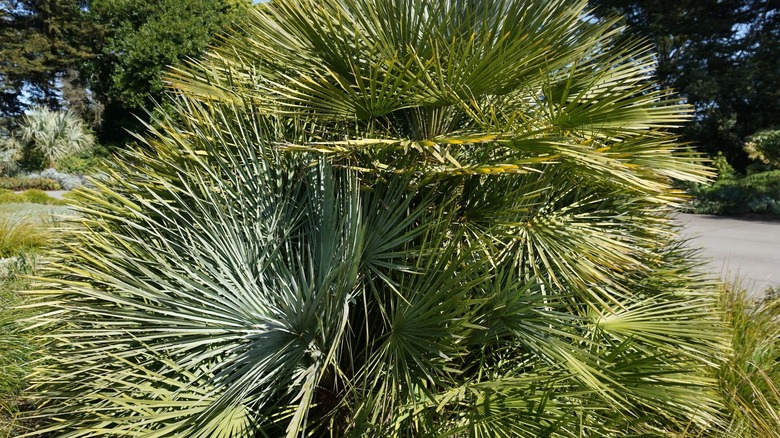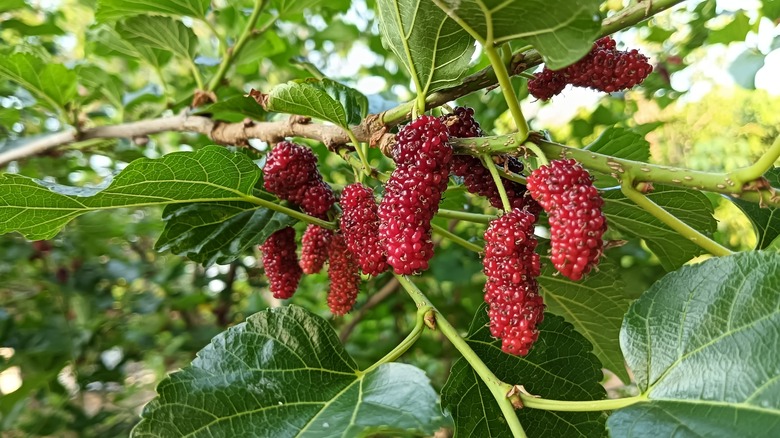Fruit And Berry Trees To Grow In Your Yard That Birds Love
Growing fruit and berry trees is a great way to attract a diverse range of birds to your yard, while also contributing to the well-being of our feathered friends. In fact, planting bird-friendly trees is one of the most satisfying ways to help birds sustain themselves, especially through winter when food for these winged creatures can be scarce. Having a yard full of birds can also help to control insect populations because they often feed on common plant pests. Types of trees that produce delicious delights that birds love to feast on include black cherry trees, crabapple trees, and pawpaw trees.
While providing sources of food in the garden is hugely beneficial to birds, the sheer joy of seeing a flock outside of your home can bring a sense of happiness and contentment. Many of us enjoy seeing birds flock to our yards, but research has shown that birdwatching can actually boost mental health. Dr. Daniel Cox from the University of Exeter said, "This study starts to unpick the role that some key components of nature play for our mental well-being. Birds around the home, and nature in general, show great promise in preventative health care, making cities healthier, happier places to live." Therefore, to attract birds to your yard, consider growing these fruit and berry trees.
More than 40 species of birds feast on black cherry trees
The black cherry tree (Prunus serotina) is a fast-growing tree that pollinators and birds can't get enough of. The small, deep purple-black fruits produced by this tree have a juicy inner flesh that is known to be enjoyed by at least 47 different species of birds. Feathered friends commonly spotted feasting on black cherries when they ripen from mid-August to late October include the white-throated sparrow, northern mockingbird, redheaded woodpecker, and rose-breasted grosbeak. While the black cherry tree is excellent for attracting more birds, it should be noted that this tree is a poor choice if you keep livestock in your yard. The University of Alabama Arboretum states that more livestock die from consuming parts of this tree than any other plant.
The black cherry tree is medium in size, reaching an ultimate height of between 50 and 80 feet. It is ideal for growing in USDA hardiness zones 3 to 9, where it prefers moist, well-draining soils. Aim to keep the soil around the black cherry evenly moist. It does not cope well in very dry or very wet growing mediums. The tree performs best in full sun rather than partial shade, so it should ideally be planted in an open area where it won't be covered by the canopy of taller trees. The tree produces clusters of small white flowers in late spring or early summer, adding interest to the landscape, before developing into black fruits known as drupes.
Plant hackberry trees to attract over two dozen bird species to your yard
Hackberry trees (Celtis occidentalis) produce small fruits that start out orange and develop to a dark shade of purple when they mature in September or October. In fact, more than two dozen bird species are known to relish hackberry fruits, such as wild turkeys, pheasants, yellow-bellied sapsuckers, brown thrashers, robins, cardinals, flickers, and cedar waxwings. Although hackberries ripen in early fall, they provide an excellent source of food for birds throughout winter, and even into spring. Unlike many berry trees, the fruits of hackberry remain on the tree through several seasons when food for wildlife may be scarce.
As a large, deciduous tree that can reach heights of up to 100 feet, the hackberry tree is a good choice for spacious gardens. On top of its bird-attracting benefits, the broad-crowned, fast-growing tree can be planted in your yard as a fairly quick way to create shade during the warmer months. Hackberry trees are tolerant of a wide range of conditions including drought, full sun, shade, and varying soil pH levels. This makes them great for a variety of climates, and for gardeners who aren't particularly attentive.
Enjoy songbirds flocking to your garden for crabapples
Crabapple trees (Malus spp.) produce fruits that attract a wide range of birds and mammals. Different types of crabapples can ripen at different times, and this is also influenced by the local climate. Crabapples can be ready to eat as early as June or as late as November, and often the fruits can persist on the trees all through winter to provide an ongoing source of food for wildlife. While the apples are relished by songbirds, grouse, and pheasants, they may also attract less desirable creatures to your yard, such as opossums, skunks, raccoons, and foxes.
There are many different types of crabapple trees you can grow in your yard, including white, purple, and pink-flowering varieties that can add gorgeous color to the landscape during spring. Crabapple trees are small, reaching around 20 feet in height. This makes them perfect for gardens where space may be limited. The trees perform best in partial shade, so they can be grown beneath the shade of taller trees. Aim to keep the soil moist for optimum growth. This could be achieved with regular watering, or by mulching the ground around the tree to retain moisture. The best type of mulch for your garden and your crabapple tree is typically an organic mulch. These break down into the soil over time to improve water retention and also increase the level of nutrients.
Elderberries are popular with 45 species of birds
Want to get a wide variety of birds visiting your yard? The elderberry tree (Sambucas spp.) could be the best way to achieve this, since as many as 45 species of birds are known to find the fruits of this plant irresistible. The fruits of this tree ripen in late August and September as small, purple-black colored berries with a sour flavor. However, it isn't all good news, because many pests also find elderberries delicious. Raccoons, mice, and squirrels have all been known to feast on elderberries, while deer can be attracted to the tree for its fruit, twigs, and leaves. If you want to keep pests out of your garden, planting elderberry trees may not be a smart idea.
Elderberry plants can be grown as trees or shrubs to heights of between 10 and 20 feet, making them a versatile choice for homeowners. They are most attractive between April and June when masses of creamy flower clusters adorn the tree, filling the surrounding air with a sweet aroma. These plants are very easy to grow and care for as long as they are planted in suitable conditions. They grow best in soils that are consistently moist, so avoid sandy soils or soils that drain too quickly. Though elderberry trees can tolerate occasional dry spells, drought can affect their ability to thrive. They can be kept in partial shade, but will flower and fruit more profusely in full sun.
Feathered friends love the banana-like taste of pawpaw fruits
The pawpaw tree (Asimina triloba) produces fruits with a banana flavor that is popular with wildlife. The fruits can be between 3 and 6 inches in length, with an initial green color that develops to brown or black as they mature. The skin of ripe fruits is wrinkly, and the inner flesh is a cross between custard and mashed banana mixed with dark seeds. You can expect to find birds flocking to your pawpaw tree from late August to mid-October when the fruit ripens. Unfortunately, pawpaw fruits are also a favorite snack amongst raccoons, squirrels, opossums, and foxes, so you may wish to avoid planting this tree if you have a pest problem.
As a small tree, pawpaws rarely exceed 20 feet in height, so they can work well in smaller yards. They have very large, dark green leaves that droop downwards from the stems of the plant. One of the best parts of growing a pawpaw tree is watching the unique flowers bloom in spring. The purple-red flowers have leather-like leaves and span around 2 inches across. Pawpaw trees are suitable for growing through USDA hardiness zones 5 to 8, preferring soil that is rich, deep, and well-draining. The trees can fruit when grown in the shade, however, they will perform best when kept in a sunny spot.
Blue jays and mockingbirds love the red fruits of Simpson's stopper
Simpson's stopper (Myrcianthes fragrans) is a Florida native that can be grown as a shrub or a small tree. It is excellent at attracting pollinators such as bees, butterflies, and birds to the garden with its fragrant white flowers. When the flowers develop into small orange or red fruits in late summer and early fall, a range of bird species, such as mockingbirds, cardinals, buntings, and bluejays, will return to the tree to feast. The dense canopy is also known to offer valuable protection to birds.
Simpson's stopper is considered to be a small tree at a mature height of around 20 feet, however, it can take up a significant amount of space in a yard with an expected spread of up to 15 feet. Before selecting this plant to encourage birds to your yard, be sure to check you have enough space for it to grow. With fragrant leaves and flowers, Simpson's stopper can make a nice addition to seating areas in the garden, so the pleasant aroma can be enjoyed. This is an incredibly low-maintenance tree, making it ideal for beginner gardeners and homeowners with limited time to dedicate to plant care. It thrives in drought and will grow equally well in full sun or full shade.
Eastern red cedar provides an important source of food for over 50 bird species
The small, berry-like fruits of the eastern red cedar (Juniperus virginiana) are incredibly popular with birds, regularly attracting more than 50 different species. Beaks that are known to nibble on the Eastern red cedar tree include gray catbirds, brown thrashers, cedar waxwings, and the northern mockingbird. Interestingly, the "berries" that these birds love are actually cones. The cones have blue-purple scales and are surrounded by a white, waxy coating. Though the cones are ripe around September time, they remain on the tree right through winter and can even still be present the following spring, providing an excellent source of winter nutrition for feathered friends.
This evergreen tree is medium in size, growing to heights of between 40 and 50 feet tall, with a spread of 10 to 20 feet. Eastern red cedars are fast-growing with attractive, dense foliage. They are also one of the most fragrant trees that'll make your yard smell better than ever. The aromatic bark is not only a pleasure for the senses, but it also works to repel insects, making this tree a great choice to grow in the garden for a variety of reasons. Once established, the tree is low-maintenance to care for, however, when young it will need plenty of supplemental watering to develop a strong root system.
Attract bluebirds and catbirds with American mountain ash trees
The American mountain ash (Sorbus americana) is a low maintenance ornamental tree that will have birds flocking to your yard. It produces fruits that ripen in August and remain on the tree through early winter. Due to this, the plant is an important provider of food for birds that migrate in fall. Species such as eastern bluebirds, brown thrashers, gray catbirds, and cedar waxwings are partial to the fruits of the American mountain ash, which take the shape of small, glossy, bright red berries. While birds flock to this tree for its fruits, other wildlife might also take interest that homeowners may be less pleased about. Moose and deer commonly feed on the branches, twigs, and leaves of the American mountain ash, while smaller weasel-like mammals, such as fishers and martens, also feast on this tree.
Growing to heights of between 15 and 30 feet, the American mountain ash is an attractive tree that works well as an ornamental in most yards. It produces clusters of white flowers between May and July, set against the background of serrated, dark green foliage. The tree should be grown in acidic soils that are rich in organic matter and kept consistently moist. American mountain ash trees perform best in full sun, but they can also tolerate some partial shade, so you could plant them beneath the canopy of open-branched trees, especially in climates that experience hot summers.
Grow cabbage palm trees for hungry birds in hot climates
South Carolina and Florida's state tree, the cabbage palm (Sabal palmetto), is an ideal tree to attract birds in hot climates. Suitable for growing in USDA hardiness zones 8b to 11, the cabbage palm produces blackberry-like fruits measuring around half an inch across. They are a favorite source of food for a variety of birds, including cardinals, blue jays, robins, mockingbirds, fish crows, and ring-billed gulls. The shiny fruits can also attract unwelcome wildlife such as raccoons, and if you don't remove dropped fruits when they fall to the ground, you may find yourself with a rodent problem.
The slender cabbage palm can reach up to 90 feet in height, but they more commonly top out at around 50 feet. Their narrow shape means that despite being a tall tree, they are suitable for planting in small gardens. Anyone with a lawn area that is more than 3 feet wide will be able to grow a cabbage palm. The tree is super easy to look after when grown in hot climates, requiring no special care once planted. Cabbage palms will adapt well to various soil types, including dry and sandy spots. Water the plant thoroughly until well established, and then it will pretty much take care of itself.
Keep more than 40 species of birds fed by growing red mulberry trees
The red mulberry tree (Morus rubra) produces berries that are wildly popular with birds, with at least 44 different species known to feast on the fruits. Cuckoos, tanagers, gray-cheeked thrush, and chestnut-sided warblers are among the winged creatures who love red mulberries, but some people believe you should think twice before planting this bird-attracting tree in your yard. Although flocks of feathered friends visiting your garden might be delightful at first, you may soon find that the mess red mulberry trees leave behind isn't worth it. The red-black fruits, which resemble blackberries, stain any surface they come into contact with, which could include garden furniture, decking, patios, and driveways. Because of this, it's best to plant red mulberry trees towards the back of a garden or on a lawn where staining won't be as much of an issue.
Red mulberry trees are hardy through zones 5 to 11. They reach heights of up to 45 feet with a maximum width of 35 feet. Although the tree is native to damp, woody areas, it is highly adaptable and will grow in both dry and moist sites. It is also very versatile in terms of exposure to light and can thrive in full sun or full shade, making it suitable for planting in many different types of gardens.
